Financial projection of a Meal Kit Start-Up
This is a modified version of the report for Enterprise in Action in Bath Full Time MBA Class of 2020.
Financial projection of a Meal Kit Start-Up
Introduction
This article will show how to make financial plan for a start-up using an example which is a meal kit start-up. This figure is the result of financial projection.

Funding (Key Resource)
There are mainly three option to fund the money to start the business. First, to borrow the money from the financial institution such as banks (called debt) and second, to be funded by venture capital (VC) and crowd funding. however, it is assumed the business will be fully funded by VC with 10% cost of capital. this is primary because debt is less likely to be borrowed by the firm which do not have more than several years cash generating history and the crowd funding has ambiguously when and how much the firm can borrow the money.
Projected turnover
It is assumed until FY2021 (Year 1 of financial projection), the business will have a half of the target market. The total number of the international students in Bath and Bristol from East Asia and South East Asia was 6,671 people according to UK government statics. therefore, the projected turnover (revenue) would be £720,468 as a result of the assumptions which revenue would be £4.5 per unit and average purchase times per customer would be 48 (or monthly the customer would purchase 4 unit on general). From Year 2 (2022), it is projected the business will expand to other areas in UK. Hence the number of the target customers will be also enlarged to 184,955 people according to the UK government. It is estimated the share of the market in Year 2, 3, 4 and 5 are 10%, 30%, 40% and 50%. As a result of estimations of the market share, the projected turnover would be calculated to ‘£3,995,028’, ‘£11,985,084’, ‘£15,980,112’ and ‘£19,975,140’ respectively in the same split of the calculation of Year 1.
Projected gross profit and GP% (Financial projection)
Projected gross profit is earned by projected turnover minus material cost which is assumed £2.9. Therefore, it would be £ 1.6 (£4.5 - £2.9) multiplied by units sold which are the number of the customer the business will earn multiplied by 48 (average purchase times per customer). In addition, projected gross profit margin (GP%) would be projected gross profit divided by projected turnover.
Projected EBITDA (Financial projection)
Other costs would also be charged to run the business. Assumed to omit minor part of costs, the ones are mainly application maintenance fee, rent fee (even if the business will not have any facilities such as kitchen and warehouse, still the function of these one will be required in the farm then this fee is for that), marketing cost and human resource cost (other cost in the financial projection). In Year 0 (2020), it is required to invest to build the application which is estimated to spend £720,000 and from Year 1, it will be charged 20% of development cost (£144,000) as a maintenance fee. The rent fee will depend on how many sales units the business will need. it is projected one sales unit has the function of kitchen and warehouse for 1,000 customers, which will cost £18,409. £8,917 rent fee in Year 0 means the business will offer the farm some materials to run. In Year 1, the business will target roughly 3,500 people and therefore it will be required 3.5 sales units. In the same spirit, the rent fees each year will be the number of sales unites multiplied by rent fee per sales unit (£18,409). On the other hand, marketing cost will be customer acquisition cost (per customer), which is assumed £0.5, multiplied by the number of the customer the business will earn each year. Finally, other costs (human cost) will required two person who are one chief and one staff charging £48,000 per sales unit from Year 0. Projected EBITDA is estimated projected turnover minus the sum of the costs each year and the numbers will be ‘- £720,000’, ‘- £121,934’, ‘£1,644’, ‘£385,409’, ‘£577,292’ and ‘£769,175’.
Free Cash Flow Forecast, NPV and IRR (Financial projection)
Free cash flow will be projected EBITDA minus amortization and depreciation (A&D) and income tax (17% of EBIT) and to be simplification, it is assumed A&D is zero. Therefore, projected EBITA is equal to projected EBIT here. As a result of the tax calculations, free cash flow will be ‘-£720,000’, ‘-£121,934’, ‘£1,364’, ‘£319,890’, ‘£479,152’ and ‘£638,415’. NPV will be projected free cash flow multiplied discount factor which is the reciprocal of 1 plus the cost of capital (10%) and multiplied the number of years. As a result of that, NPV will be £134,290 (> 0). IRR will also be 14.2%.
Break even analysis
Break even units sold is total fixed cost divided by the number that revenue per unit minus valuable cost per unit. fixed cost is equal to application maintenance and marketing cost and therefore other costs belongs to valuable cost. Hence valuable cost per unit is valuable cost divided by units sold each year. Therefore, break even units sold are ‘160,000’, ‘982,644’, ‘880,178’, ‘880,178’, ‘880,178’ and ‘880,178’.
Reference
- Lauren Sam and Camille Murdock, 2018. Business Financial Plan Herriman High School
- NICKOLAS, S., 2020. How can I Calculate Break-Even Analysis in Excel? [Online]. Available from: https://www.merchantsavvy.co.uk/mobile-payment-stats-trends/ [Accessed 8th June 2020].
Financial Review of Pendragon PLC
This is a modified version of the report for Corporate Finance in Bath Full Time MBA Class of 2020.
Financial Review of Pendragon PLC
Introduction
“Cash is fact, profit is opinion” was argued by The Economist because such accounting figures can be manipulated conveniently (Anonymous, 1997). This might imply the framework to analyze the company is changing, however, the importance of valuation and analysis itself may be stable. This report will review of Pendragon PLC (PDG.L) in terms of their financial performance, position and capability to generate cash flow. In addition, the enterprise value will be calculated using discount cash flow method (DFC) and therefore, the figure will be compared with their market value.
Review of Financial Performance
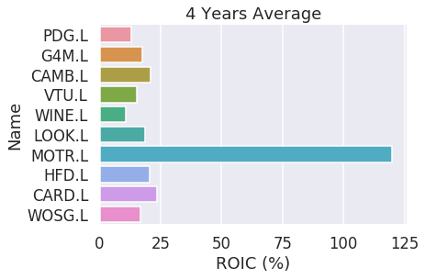
From the investor’s point of view, the performance of company can be represented by return on invested capital (ROIC). This is mainly because ROIC describe how much the company generate the cash flow using capital in which the finance providers invested such as equity and debt (Watson and Head, 2019). In general, the cash flow is indicated by net operating profit less adjusted taxes (McKinsey & Company, 2010). However, this report uses Earnings Before Interest Taxes Depreciation and Amortization (EBITDA) owing to the fact that EBITDA can be directly extracted from Income Statement which means to be more reliable than the processed one. The Figure 1 show 4 years average ROIC of PDG.L and the major competitors , which the firm can be the second least valuable for the investors because if their investment was used to the competitors or other assets, they would earn more money. Moreover, the ROIC of PDG.L was 0.24% in 2018, which meant not only the least valuable firm but also approximately 13% smaller than its average. ROIC could be decomposed in terms of profitability and efficiency using mainly EBITA Margin and Invested Capital Turnover respectively (ibid). The perspective of cost structure is also important and is represented by two figures which are sales cost ratio and selling, general & administrative (SGA) ratio, however, these number of PDG.L was almost stable for 4 years (ibid). Therefore, Figure 2 show ROIC decomposition by profitability and efficiency. This figure indicates PDG.L has the lower profitability and efficiency than competitors, in contrast, firms with larger ROIC has either profitability or efficiency then both cannot hold at the same time in this industry which is retail and repair of used and new cars. What is the main cause of low ROIC can be recognized to see ROIC trees (Figure 3 and 4). These trees show EBITDA margin, fixed asset turnover and accounts payable turnover of PDG.L are significantly lower than the competitors average. Relatively low EBITDA margin means they might make less effort to cut operating expenses (Investopedia, 2019). Less fixed asset turnover signifies their fixed-asset investments management can be smaller effective (ibid). Lower accounts payable turnover connotes there can be smaller amount cash flow to pay their short-term obligations (ibid).
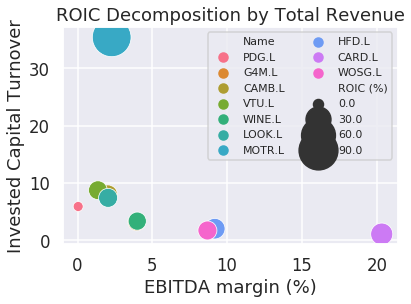


Review of Financial Position
There are two aspects to analyze financial position of the firm, which are liquidity and gearing (coverage). The major indicators of liquidity are quick rate and current rate. In comparison with the average of competitors, these ratios are 17% (0.97) and 28% (0.22) lower respectively. This means PDG.L has less capability to pay short term obligations and therefore they are more likely to be bankruptcy (Investopedia, 2019). Gearing is represented by capital gearing, debt-to-equity and interest coverage ratio. They have moderate capital gearing (0.25) and debt-to-equity (4.10) because these difference with the average of competitors are 10% and 5% higher, however, interest coverage of them (2.39) is 84% smaller. This means their interest expense can be quite larger than their earnings therefore the likelihood of bankruptcy might be higher and this statement is supported both liquidity and gearing (ibid).
Review of the cash generation
Most investors are interested in the structure and capability to earn free cash flow. This is because the value of company can be driven by cash flow which is created their ROIC and revenue growth (McKinsey & Company, 2010). Free cash flow of PDG.L has been negative for 5 years, however, operating cash flow has been positive for the same period and larger than the average . This means capital expenditure of them has been considerably larger than operating cash flow . This was mainly due to the fact that they recognized a significant impairment of £88.8M against the carrying value of goodwill in a number of its Cash Generating Units (AR18p77). Therefore, if they did not recognize the impairment, free cash flow would £34.6M, which means they might have the capability to earn cash flow because free cash flow exclude goodwill was positive and such impairment is less likely to be happen.
DCF Based Valuation
There is the history of stock price in Figure 5, which indicate after global recession in 2008, although until 2016 the price had been recovering, it is decreasing again and therefore enterprise value as market capitalization (MC) is also declining to £158.97M as of 2019 according to Yahoo! Finance. This decrease could recognize the historical cumulative log return and total relative one of stock price in Figure 6. However, some people argue that MC do not represent the value of firm. There are three approaches to evaluate the company which are income, cost and market approach mainly including MC (McKinsey & Company, 2010). Discount cash flow method can be the most popular income approach valuation one, which the estimated future free cash flows multiplying weighted average cost of capital (WACC) as a discount factor and then those discounted free cash flows is summed up is considered as enterprise value (ibid). Assumed CAPM theory hold, WACC is calculated as 3.81% which might mean the investor lost the opportunity to earn more money investing other assets such as stocks or bonds due to the fact that average ROIC is 12.92%. The determination of value drivers is important to estimate future free cash flow. In general, some of key drivers are revenue growth, EBITDA margin and tax rate. As a base line scenario, those are assumed as compound average growth rate (CAGR, -0.24% ), weighted average EBITDA margin (1.10%) and British tax rate (19% in 2019 and 17% from 2020) respectively. Therefore, CAGR estimated future 5 years revenue (2019-2023) and then EBITDA was calculated by multiplying the revenue with EBITDA margin. Assumed percentage of depreciation and amortization against revenue is constant and equal to the figure in 2018 (0.66%), the future depreciation and amortization was earned to multiply the revenue with the percentage. The future earnings before interest and taxes (EBIT) was reckoned the EBITDA minus depreciation and amortization. Future free cash flow (FCF) was estimated the EBIT minus operating cash tax which EBIT multiplied tax rate. Finally, the enterprise value was £498.04M owing to the fact that those 5 years FCF was discounted by WACC and totaled. In comparison with market cap, the estimated value was almost 3 times higher which means the current market value can be undervalued by market participants. However, the base line of DCF method might be unreliable because of the uncertainty of prediction for key drivers primary revenue growth and therefore it should be mitigated to use some feasible scenarios which should be averaged weightily based on it’s feasibility or to adapt Monte Carlo simulation (MC). As a result of the adaption (see figure 7), the enterprise value was £430.04M, which meant several scenarios were smoothened using two normal distributions for revenue growth and EBITDA margin, both of which have 2% standard deviation.

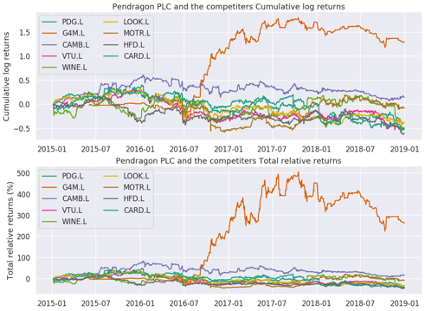
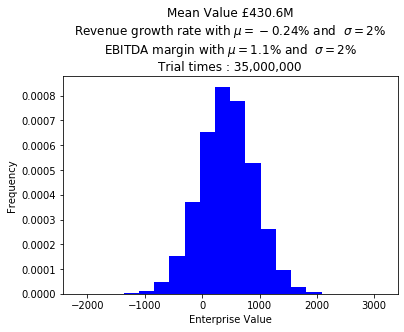
Conclusion
This report has reviewed PDG.L’s financial conditions and estimated their enterprise value. As a result of the review, EBITDA margin, fixed asset and account payable turnover were considerably smaller than major competitors. In addition, in terms of liquidity and gearing, they might be lower capability to pay short term debt. According to their cash generation, they have relatively large operating cash flow, however, capital expenditure was higher than their cash earning ability from business. This might mean lower turnovers lead to lower liquidity and gearing, therefore, capital expenditure may become larger and thus their free cash flow earning ability become weaker. This can be supported by that estimated enterprise value with DCF and MC (£430.04M) was approximately 3 times larger than their market cap. This may mean market participants are significantly concerned to their capability to earn free cash flow more than assumed and estimated in this report. The valuation did not consider inflation, foreign currency, pension obligation effects and other factors to affect the value, however, these should be done so to calculate the value more precisely.
Reference
- Anonymous, 1997. A star to sail by? The Economist, 344(8028), pp.53–55.
- Cambria Automobiles PLC. (CAMB.L), 2019. Balance Sheet. Yahoo!Finance. Retrieved from: https://finance.yahoo.com/quote/CAMB.L/balance-sheet?p=CAMB.L [Accessed 20 December 2019].
- Cambria Automobiles PLC. (CAMB.L), 2019. Income statement. Yahoo!Finance. Retrieved from: https://finance.yahoo.com/quote/CAMB.L/financials?p=CAMB.L [Accessed 20 December 2019].
- Cambria Automobiles PLC. (CAMB.L), 2019. Key Statistics. Yahoo!Finance. Retrieved from: https://finance.yahoo.com/quote/CAMB.L/key-statistics?p=CAMB.L [Accessed 20 December 2019].
- Cambria Automobiles PLC. (CAMB.L), 2019. Statement of Cash Flows. Yahoo!Finance. Retrieved from: https://finance.yahoo.com/quote/CAMB.L/cash-flow?p=CAMB.L [Accessed 20 December 2019].
- Card Factory PLC. (CARD.L), 2019. Balance Sheet. Yahoo!Finance. Retrieved from: https://finance.yahoo.com/quote/CARD.L/balance-sheet?p=CARD.L [Accessed 20 December 2019].
- Card Factory PLC. (CARD.L), 2019. Income statement. Yahoo!Finance. Retrieved from: https://finance.yahoo.com/quote/CARD.L/financials?p=CARD.L [Accessed 20 December 2019].
- Card Factory PLC. (CARD.L), 2019. Key Statistics. Yahoo!Finance. Retrieved from: https://finance.yahoo.com/quote/CARD.L/key-statistics?p=CARD.L [Accessed 20 December 2019].
- Card Factory PLC. (CARD.L), 2019. Statement of Cash Flows. Yahoo!Finance. Retrieved from: https://finance.yahoo.com/quote/CARD.L/cash-flow?p=CARD.L [Accessed 20 December 2019].
- Financial Times (FT), 2019. Ten year government bond spreads. [online] Available from: https://markets.ft.com/data/bonds/government-bonds-spreads [Accessed 20 December 2019].
- Gear4music Holdings PLC. (G4M.L), 2019. Balance Sheet. Yahoo!Finance. Retrieved from: https://finance.yahoo.com/quote/G4M.L/balance-sheet?p=G4M.L [Accessed 20 December 2019].
- Gear4music Holdings PLC. (G4M.L), 2019. Income statement. Yahoo!Finance. Retrieved from: https://finance.yahoo.com/quote/G4M.L/financials?p=G4M.L [Accessed 20 December 2019].
- Gear4music Holdings PLC. (G4M.L), 2019. Key Statistics. Yahoo!Finance. Retrieved from: https://finance.yahoo.com/quote/G4M.L/key-statistics?p=G4M.L [Accessed 20 December 2019].
- Gear4music Holdings PLC. (G4M.L), 2019. Statement of Cash Flows. Yahoo!Finance. Retrieved from: https://finance.yahoo.com/quote/G4M.L/cash-flow?p=G4M.L [Accessed 20 December 2019].
- Halfords Group plc. (HFD.L), 2019. Balance Sheet. Yahoo!Finance. Retrieved from: https://finance.yahoo.com/quote/HFD.L/balance-sheet?p=HFD.L [Accessed 20 December 2019].
- Halfords Group plc. (HFD.L), 2019. Income statement. Yahoo!Finance. Retrieved from: https://finance.yahoo.com/quote/HFD.L/financials?p=HFD.L [Accessed 20 December 2019].
- Halfords Group plc. (HFD.L), 2019. Key Statistics. Yahoo!Finance. Retrieved from: https://finance.yahoo.com/quote/HFD.L/key-statistics?p=HFD.L [Accessed 20 December 2019].
- Halfords Group plc. (HFD.L), 2019. Statement of Cash Flows. Yahoo!Finance. Retrieved from: https://finance.yahoo.com/quote/HFD.L/cash-flow?p=HFD.L [Accessed 20 December 2019].
- Investopedia, 2019. Accounts Payable Turnover Ratio Definition. [online] Available from: https://www.investopedia.com/terms/a/accountspayableturnoverratio.asp [Accessed 20 December 2019].
- Investopedia, 2019. Debt-To-Equity Ratio – D/E. [online] Available from: https://www.investopedia.com/terms/d/debtequityratio.asp [Accessed 20 December 2019].
- Investopedia, 2019. EBITDA Margin. [online] Available from: https://www.investopedia.com/terms/e/ebitda-margin.asp [Accessed 20 December 2019].
- Investopedia, 2019. Fixed Asset Turnover Ratio Definition. [online] Available from: https://www.investopedia.com/terms/f/fixed-asset-turnover.asp [Accessed 20 December 2019].
- Investopedia, 2019. How Do I Use the CAPM to Determine Cost of Equity?. [online] Available from: https://www.investopedia.com/ask/answers/022515/how-do-i-use-capm-capital-asset-pricing-model-determine-cost-equity.asp [Accessed 20 December 2019].
- Investopedia, 2019. How to Analyze a Company’s Financial Position. [online] Available from: https://www.investopedia.com/articles/fundamental/04/063004.asp [Accessed 20 December 2019].
- Investopedia, 2019. Interest Coverage Ratio Definition. [online] Available from: https://www.investopedia.com/terms/i/interestcoverageratio.asp [Accessed 20 December 2019].
- Investopedia, 2019. Quick Ratio Definition. [online] Available from: https://www.investopedia.com/terms/q/quickratio.asp [Accessed 20 December 2019].
- Investopedia, 2019. Weighted Average Cost of Capital – WACC. [online] Available from: https://www.investopedia.com/terms/w/wacc.asp [Accessed 20 December 2019].
- Lookers PLC. (LOOK.L), 2019. Balance Sheet. Yahoo!Finance. Retrieved from: https://finance.yahoo.com/quote/LOOK.L/balance-sheet?p=LOOK.L [Accessed 20 December 2019].
- Lookers PLC. (LOOK.L), 2019. Income statement. Yahoo!Finance. Retrieved from: https://finance.yahoo.com/quote/LOOK.L/financials?p=LOOK.L [Accessed 20 December 2019].
- Lookers PLC. (LOOK.L), 2019. Key Statistics. Yahoo!Finance. Retrieved from: https://finance.yahoo.com/quote/LOOK.L/key-statistics?p=LOOK.L [Accessed 20 December 2019].
- Lookers PLC. (LOOK.L), 2019. Statement of Cash Flows. Yahoo!Finance. Retrieved from: https://finance.yahoo.com/quote/LOOK.L/cash-flow?p=LOOK.L [Accessed 20 December 2019].
- McKinsey & Company, 2010. VALUATION. FIFTH EDITION. John Wiley & Sons, Inc.
- Motorpoint Group PLC. (MOTR.L), 2019. Balance Sheet. Yahoo!Finance. Retrieved from: https://finance.yahoo.com/quote/MOTR.L/balance-sheet?p=MOTR.L [Accessed 20 December 2019].
- Motorpoint Group PLC. (MOTR.L), 2019. Income statement. Yahoo!Finance. Retrieved from: https://finance.yahoo.com/quote/MOTR.L/financials?p=MOTR.L [Accessed 20 December 2019].
- Motorpoint Group PLC. (MOTR.L), 2019. Key Statistics. Yahoo!Finance. Retrieved from: https://finance.yahoo.com/quote/MOTR.L/key-statistics?p=MOTR.L [Accessed 20 December 2019].
- Motorpoint Group PLC. (MOTR.L), 2019. Statement of Cash Flows. Yahoo!Finance. Retrieved from: https://finance.yahoo.com/quote/MOTR.L/cash-flow?p=MOTR.L [Accessed 20 December 2019].
- Naked Wines PLC. (WINE.L), 2019. Balance Sheet. Yahoo!Finance. Retrieved from: https://finance.yahoo.com/quote/WINE.L/balance-sheet?p=WINE.L [Accessed 20 December 2019].
- Naked Wines PLC. (WINE.L), 2019. Income statement. Yahoo!Finance. Retrieved from: https://finance.yahoo.com/quote/WINE.L/financials?p=WINE.L [Accessed 20 December 2019].
- Naked Wines PLC. (WINE.L), 2019. Key Statistics. Yahoo!Finance. Retrieved from: https://finance.yahoo.com/quote/WINE.L/key-statistics?p=WINE.L [Accessed 20 December 2019].
- Naked Wines PLC. (WINE.L), 2019. Statement of Cash Flows. Yahoo!Finance. Retrieved from: https://finance.yahoo.com/quote/WINE.L/cash-flow?p=WINE.L [Accessed 20 December 2019].
- Pendragon PLC, 2018. Pendragon PLC Annual Report 2018.
- Pendragon PLC. (PDG.L), 2019. Balance Sheet. Yahoo!Finance. Retrieved from: https://finance.yahoo.com/quote/PDG.L/balance-sheet?p=PDG.L [Accessed 20 December 2019].
- Pendragon PLC. (PDG.L), 2019. Income statement. Yahoo!Finance. Retrieved from: https://finance.yahoo.com/quote/PDG.L/financials?p=PDG.L [Accessed 20 December 2019].
- Pendragon PLC. (PDG.L), 2019. Key Statistics. Yahoo!Finance. Retrieved from: https://finance.yahoo.com/quote/PDG.L/key-statistics?p=PDG.L [Accessed 20 December 2019].
- Pendragon PLC. (PDG.L), 2019. Statement of Cash Flows. Yahoo!Finance. Retrieved from: https://finance.yahoo.com/quote/PDG.L/cash-flow?p=PDG.L [Accessed 20 December 2019].
- Simply Wall St, 2019. Why Deere & Company’s (NYSE:DE) Return On Capital Employed Might Be A Concern [Online]. Available from: https://finance.yahoo.com/news/why-deere-company-nyse-return-125612798.html [Accessed 20 December 2019].
- Statista, 2019. Average market risk premium in the United Kingdom (UK) 2011-2019 [online] Available from: https://www.statista.com/statistics/664833/average-market-risk-premium-united-kingdom/ [Accessed 20 December 2019].
- Vertu Motors Plc. (VTU.L), 2019. Balance Sheet. Yahoo!Finance. Retrieved from: https://finance.yahoo.com/quote/VTU.L/balance-sheet?p=VTU.L [Accessed 20 December 2019].
- Vertu Motors Plc. (VTU.L), 2019. Income statement. Yahoo!Finance. Retrieved from: https://finance.yahoo.com/quote/VTU.L/financials?p=VTU.L [Accessed 20 December 2019].
- Vertu Motors Plc. (VTU.L), 2019. Key Statistics. Yahoo!Finance. Retrieved from: https://finance.yahoo.com/quote/VTU.L/key-statistics?p=VTU.L [Accessed 20 December 2019].
- Vertu Motors Plc. (VTU.L), 2019. Statement of Cash Flows. Yahoo!Finance. Retrieved from: https://finance.yahoo.com/quote/VTU.L/cash-flow?p=VTU.L [Accessed 20 December 2019].
- Watches of Switzerland Group PLC. (WOSG.L), 2019. Balance Sheet. Yahoo!Finance. Retrieved from: https://finance.yahoo.com/quote/WOSG.L/balance-sheet?p=WOSG.L [Accessed 20 December 2019].
- Watches of Switzerland Group PLC. (WOSG.L), 2019. Income statement. Yahoo!Finance. Retrieved from: https://finance.yahoo.com/quote/WOSG.L/financials?p=WOSG.L [Accessed 20 December 2019].
- Watches of Switzerland Group PLC. (WOSG.L), 2019. Key Statistics. Yahoo!Finance. Retrieved from: https://finance.yahoo.com/quote/WOSG.L/key-statistics?p=WOSG.L [Accessed 20 December 2019].
- Watches of Switzerland Group PLC. (WOSG.L), 2019. Statement of Cash Flows. Yahoo!Finance. Retrieved from: https://finance.yahoo.com/quote/WOSG.L/cash-flow?p=WOSG.L [Accessed 20 December 2019].
- Watson, D. and Head, A., 2019. Corporate Finance Principles and Practice. 8th edition. Pearson Education Limited.
Marketing Plan for John Lewis
This is a modified version of the report for Strategic Marketing in Bath Full Time MBA Class of 2020.
Marketing Plan for John Lewis
Introduction
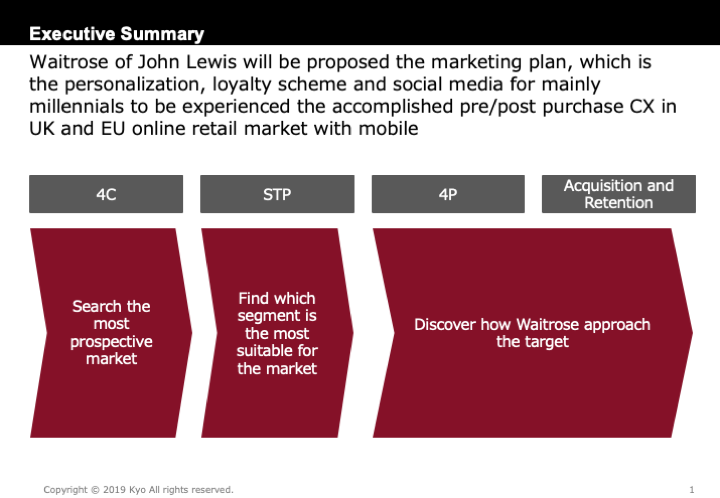
This note was written for the slides of Strategic marketing assignment. The slides have 5 pages including executive summary. The title of remains were 4C, STP, 4P and ‘Customer Acquisition and Retention’. Therefore, this note was constructed 4 paragraphs for supplementation to each slide. Besides, the reference below were for this note and slides.
4C

Although the sales growth of retailers in the UK is flat, the ones of high-end market are raising, for example, Harrods (23%) in 2018. Therefore, John Lewis might be able to concentrate on high-end market. In addition, Ocado of Online grocery retailers’ market shares is 13.4% in the UK in 2014. If Waitrose of John Lewis merged or rebranded it, the total share would be 18.4% which was still almost 20% lower than Tesco (as of 2014) and AmazonFresh (as of 2016), however, would rank 3rd place. However, the share of Tesco has decreased to 27% from 39.1% in 2014 mainly due to Amazon’s penetration, therefore, although Tesco is still large, Waitrose should focus on AmazonFresh as a major competitor.
Segmentation, Targeting, and Positioning (STP)

The features of generation have some common points among regions, especially the US can be relatively similar to the UK, however, they are less similar EU countries. However, in terms of global sales share, Asia-Pacific (37.6%) and the US (32%) are larger than Europe (25.3%), therefore, after Waitrose of John Lewis gain share in the UK and EU, they should enter this market with the retail stores to adapt omni-channel strategy.
Marketing Mix (4P)
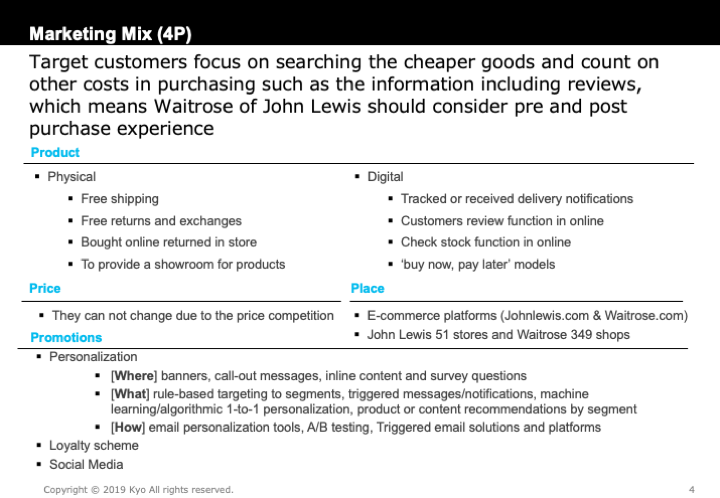
Although mobile payment users are 25% of British millenniums, more than 20% of them have tried and lapsed this method mainly via Apple Pay and Pingit which Barclays operated. This figure is relatively lower than EU countries, one of which is Italy having 37%. Therefore, Waitrose of John Lewis should adapt at least these two mobile platformers and PayPal (an existing non-bank financial brand) to improve CX. In addition, Pinterest is a less developed social media in comparison with other social channels primary Instagram. Thus, John Lewis can invest them to promote their products.
Customer Acquisition and Retention

The personalization, especially basket page can raise average order value (AOV). Therefore, this promotion can increase page not only views, conversion and retention rate but also AOV. However, the investment has to be commensurate with the cost, mainly acquisition one, the average of which for those who installed and registered on mobile shopping apps was totally $17.93 and those who made a purchase in 2019 was $39.38, which was almost half of 2017. On the other hand, AOV from a mobile phone was $ 86.47 in 2019 Q2. Thus, if this investment affect AOV negatively, it can be justified.
Reference
- Accenture, 2014. Accenture’s 2014 UK Financial Services Customer Survey.
- Adjust, 2019. Global mobile shopping app user acquisition costs 2017-2019. Statista [viewed 2 December 2019]. Available from: https://www.statista.com/statistics/1060743/mobile-shopping-apps-user-acquisition-cost-uk/
- Adjust, 2019. Mobile shopping apps user acquisition costs in the UK 2019. Statista [viewed 2 December 2019]. Available from: https://www.statista.com/statistics/1060743/mobile-shopping-apps-user-acquisition-cost-uk/
- Adjust, 2019. Mobile shopping apps: user acquisition rate in the UK 2019. Statista [viewed 2 December 2019]. Available from: https://www.statista.com/statistics/1060733/mobile-shopping-apps-user-acquisition-rate-uk/
- Deloitte, 2017. Bling it on What makes a millennial spend more.
- Eurostat, 2019. Population: Structure indicators [Online]. Available from: [http://appsso.eurostat.ec.europa.eu/nui/show.do?query=BOOKMARK_DS-054158QID_1E427F0_UID-3F171EB0&layout=TIME,C,X,0;GEO,L,Y,0;INDIC_DE,L,Z,0;INDICATORS,C,Z,1;&zSelection=DS-054158INDIC_DE,PC_Y2549;DS-054158INDICATORS,OBS_FLAG;&rankName1=INDICATORS_1_2-12&rankName2=INDIC-DE_1_2-12&rankName3=TIME_1_0_0_0&rankName4=GEO_1_2_0_1&sortC=ASC-1FIRST&rStp=&cStp=&rDCh=&cDCh=&rDM=true&cDM=true&footnes=false&empty=false&wai=false&time_mode=NONE&time_most_recent=false&lang=EN&cfo=%23%23%23%2C%23%23%23.%23%23%23](http://appsso.eurostat.ec.europa.eu/nui/show.do?query=BOOKMARK_DS-054158_QID_1E427F0_UID-3F171EB0&layout=TIME,C,X,0;GEO,L,Y,0;INDIC_DE,L,Z,0;INDICATORS,C,Z,1;&zSelection=DS-054158INDIC_DE,PC_Y2549;DS-054158INDICATORS,OBS_FLAG;&rankName1=INDICATORS_1_2-12&rankName2=INDIC-DE_1_2-12&rankName3=TIME_1_0_0_0&rankName4=GEO_1_2_0_1&sortC=ASC-1_FIRST&rStp=&cStp=&rDCh=&cDCh=&rDM=true&cDM=true&footnes=false&empty=false&wai=false&time_mode=NONE&time_most_recent=false&lang=EN&cfo=%23%23%23%2C%23%23%23.%23%23%23) [Accessed 2 December 2019].
- Experian, 2016. Millennial Me & My Money [Online]. Available from: https://www.experianplc.com/media/news/2016/millennial-me-my-money-jan-2016/ [Accessed 2 December 2019].
- Google, 2016. Google’s Omnichannel Customer Experience Review.
- Inviqa, 2017, What millennials want: online retail in the Amazon era.
- Ipsos MORI, 2019. Tech Tracker Q1 2019 Report.
- Ipsos MORI, 2016. THE MILLENNIAL INFLUENCE.
- JOHN LEWIS PARTNERSHIP PLC, 2018. NOW & THE FUTURE.
- JOHN LEWIS PARTNERSHIP PLC, 2019. Annual Report and Accounts 2019.
- KPMG, 2017. Retail Survey 2017 What consumers are telling us.
- Lyons, K., 2016. Generation Y: a guide to a much-maligned demographic [Online]. Available from: https://www.theguardian.com/world/2016/mar/07/millennials-generation-y-guide-to-much-maligned-demographic [Accessed 2 December 2019].
- MARKETLINE, 2019. John Lewis Partnership Plc [Online]. Available from: https://advantage.marketline.com/Company/Profile/john_lewis_partnership_plc?swot [Accessed 2 December 2019].
- Mixpanel, 2017. 2017 Product Benchmarks Report.
-
Monetate, 2018. Monetate Ecommerce Quarterly Report Q4 2018. - Monetate, 2019. Average value of global online shopping orders as of 2nd quarter 2019, by device (in U.S. dollars). Statista. Statista Inc. Accessed: November 29, 2019. Available from: https://www.statista.com/statistics/239247/global-online-shopping-order-values-by-device/ [Accessed 2 December 2019].
- Pitney Bowes, 2018. 2018 Global Ecommerce Study Summary Report.
- RESEARCHSCAPE INTERNATIONAL, 2018. 2018 Trends in Personalization.
- SimilarWeb.com, 2019. johnlewis.com October 2019 Overview [Online]. Available from: https://www.similarweb.com/website/johnlewis.com [Accessed 2 December 2019].
- SimilarWeb.com, 2019. waitrose.com October 2019 Overview [Online]. Available from: https://www.similarweb.com/website/waitrose.com [Accessed 2 December 2019].
- Statista, 2019. Internet usage demographics in the United Kingdom (UK). Statista [viewed 2 December 2019]. Available from: https://www.statista.com/study/23574/internet-usage-demographics-in-the-united-kingdom-statista-dossier/
- Statista, 2019. Statista dossier about e-commerce worldwide. Statista [viewed 2 December 2019]. Available from: https://www.statista.com/study/10653/e-commerce-worldwide-statista-dossier/
- Statista, 2019. Statista dossier on department stores in the United Kingdom (UK). Statista [viewed 2 December 2019]. Available from: https://www.statista.com/study/32423/department-stores-in-the-united-kingdom-uk-statista-dossier/
- Statista, 2019. Statista dossier on online grocery shopping among UK consumers. Statista [viewed 2 December 2019]. Available from: https://www.statista.com/study/39216/uk-consumers-online-grocery-shopping-statista-dossier/
- Statista, 2019. Statista dossier on the John Lewis Partnership plc in the United Kingdom (UK). Statista [viewed 2 December 2019]. Available from: https://www.statista.com/study/27327/john-lewis-partnership-statista-dossier/
- Summit, 2018. Summit ScorecardTop 50 UK Retailers’ Online Performance2018 Edition.
- VoucherCodes, RetailMeNot, France and WBR Insights, 2018. Retail perspectives and innovation: Payments, personalization and the phygital.